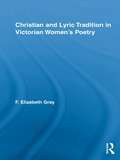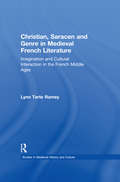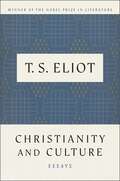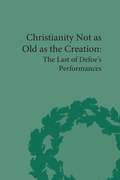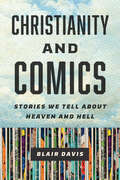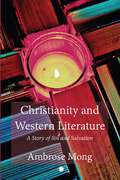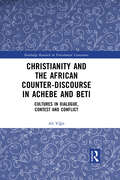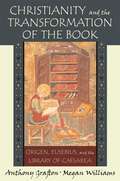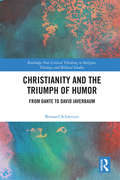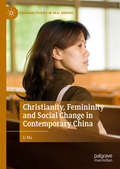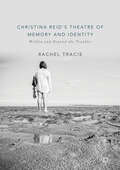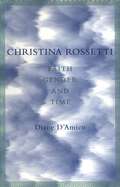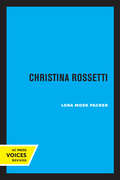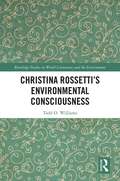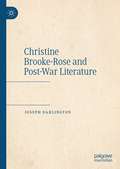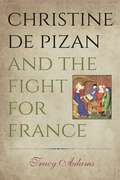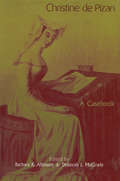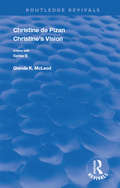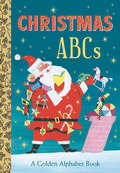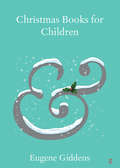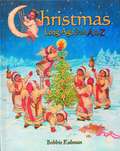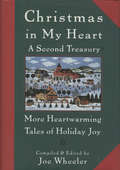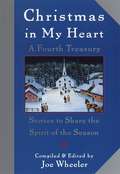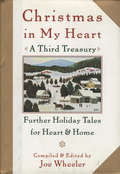- Table View
- List View
Christian and Lyric Tradition in Victorian Women's Poetry (Routledge Studies in Nineteenth Century Literature)
by F. Elizabeth GrayWomen in the Victorian period were acknowledged to be the "religious sex," but their relationship to the doctrines, practices, and hierarchies of Christianity was both highly circumscribed, which has been well documented, and complexly creative, which has not. Gray visits the importance of the literature of Christian devotion to women's creative lives through an examination of the varied ways in which Victorian women reproduced and recreated traditional Christian texts in their own poetic texts. Investigating how women poets redeployed the discourse of Christianity to uncover the multiple voices of the scriptures, to expand identity and gender constructions, and to question traditional narratives and processes of authorization, Gray contends that women found in religious poetry unexpected, liberating possibilities. Taking into account multiple voices, from the best-known female poets of the day to some of the most obscure, this study provides a comprehensive account of Victorian women's religious poetic creativity, and argues that this body of work helped shape the development of the lyric in the Victorian period.
Christian, Saracen and Genre in Medieval French Literature: Imagination and Cultural Interaction in the French Middle Ages (Studies in Medieval History and Culture #3)
by Lynn Tarte RameyThis book explores the historical and imaginary representation of the Saracen, or Muslim, in French writings from 1100 to 1500.
Christianity And Culture: Essays
by T. S. EliotOne of our most prized writers takes a poignant look at the powerful influences of religion and culture in the Western world in these two penetrating essays. The first, The Idea of a Christian Society, examines the undeniable link between religion, politics, and economy, suggesting that a real Christian society requires a direct criticism of political and economic systems. And in Notes towards the Definition of Culture, Eliot sets out to discover the true definition of &“culture,&” a word whose misuse and ambiguity presents a danger to the legacy of the Western world. Intellectually, Eliot was years ahead of his time, and these essays are an invaluable tool for analyzing and understanding the nature of society today.
Christianity Not as Old as the Creation: The Last of Defoe's Performances (The Pickering Masters)
by G A StarrThis critical edition is the first such version of Christianity Not as Old as the Creation and the first time it has been reprinted. Starr’s attribution is not only a significant contribution to Defoe scholarship, but in making it he provides an excellent ‘how to’ guide for scholars wishing to add other non-attributed works to the Defoe canon.
Christianity and Comics: Stories We Tell about Heaven and Hell
by Blair DavisThe Bible has inspired Western art and literature for centuries, so it is no surprise that Christian iconography, characters, and stories have also appeared in many comic books. Yet the sheer stylistic range of these comics is stunning. They include books from Christian publishers, as well as underground comix with religious themes and a vast array of DC, Marvel, and Dark Horse titles, from Hellboy to Preacher. Christianity and Comics presents an 80-year history of the various ways that the comics industry has drawn from biblical source material. It explores how some publishers specifically targeted Christian audiences with titles like Catholic Comics, books featuring heroic versions of Oral Roberts and Billy Graham, and special religious-themed editions of Archie. But it also considers how popular mainstream comics like Daredevil, The Sandman, Ghost Rider, and Batman are infused with Christian themes and imagery. Comics scholar Blair Davis pays special attention to how the medium’s unique use of panels, word balloons, captions, and serialized storytelling have provided vehicles for telling familiar biblical tales in new ways. Spanning the Golden Age of comics to the present day, this book charts how comics have both reflected and influenced Americans’ changing attitudes towards religion.
Christianity and Western Literature: A Story of Sin and Salvation
by Ambrose MongSome of the greatest works of Western literature have been inspired or influenced by powerful Christian themes. In this fresh evaluation of this relationship and its development over the last two millennia, Ambrose Mong studies a series of authors representative of the changing epochs. Augustine, Dante and Milton all wrote to serve the needs of the Christian community, and combine their religious themes with scholarly excellence. Meanwhile Shakespeare's plays and Coleridge's The Rime of the Ancient Mariner, though not specific to the Christian faith, nevertheless betray the dominant Christian values and imagery of their time. Finally, in Dostoevsky's The Brothers Karamazov and Greene's The Power and the Glory, Christianity is put under scrutiny, reflecting the increasing insecurity of its place in society. Throughout, Mong also shows that the themes in these works are to a certain extent universal. Creation, sin, suffering and forgiveness are perennial human concerns, beyond the exclusive purview of Christianity, and these texts serve to challenge Christian assumptions as much as they are influenced by them. Always thorough and sensitive to the unique context of each writer, Mong's analysis provides an important grounding in the way Western literature has shaped and been shaped by the religion of its day.
Christianity and the African Counter-Discourse in Achebe and Beti: Cultures in Dialogue, Contest and Conflict (Routledge Research in Postcolonial Literatures)
by Ali YiğitChristianity and the African Counter-Discourse in Achebe and Beti: Cultures in Dialogue, Contest and Conflict intervenes, in light of African literary products, the history of Christianity in Africa in late 19th and early 20th centuries, goes beyond the existing clichés about the operations of the European Christian missionaries whether Protestant or Catholic in Africa, and opens alternative ways to read the chain of missionary-native African, and missionary-European colonists relationships. Christian missionaries did not come to Africa for: their own interests, the Christianization of Africa, European colonial projects, the interests of Africans, the establishment of European civilization in Africa, but came for all. Once, there was a dialogue between the Christian missionaries and pagan Africans which was in time replaced by contest for superiority, and finally by conflict. Accordingly, the countenance of the continent has changed forever.
Christianity and the Transformation of the Book: Origen, Eusebius, and the Library of Caesarea
by Anthony GraftonChristianity and the Transformation of the Book combines broad-gauged synthesis and close textual analysis to reconstruct the kinds of books and the ways of organizing scholarly inquiry and collaboration among the Christians of Caesarea, on the coast of Roman Palestine. The book explores the dialectical relationship between intellectual history and the history of the book, even as it expands our understanding of early Christian scholarship.
Christianity and the Triumph of Humor: From Dante to David Javerbaum (Routledge New Critical Thinking in Religion, Theology and Biblical Studies)
by Bernard SchweizerThis book traces the development of religious comedy and leverages that history to justify today’s uses of religious humor in all of its manifestations, including irreverent jokes. It argues that regulating humor is futile and counterproductive, illustrating this point with a host of comedic examples. Humor is a powerful rhetorical tool for those who advocate and for those who satirize religious ideals. The book presents a compelling argument about the centrality of humor to the story of Western Christianity’s cultural and artistic development since the Middle Ages, taking a multi-disciplinary approach that combines literary criticism, religious studies, philosophy, theology, and social science. After laying out the conceptual framework in Part 1, Part 2 analyzes key works of religious comedy across the ages from Dante to the present, and it samples the breadth of contemporary religious humor from Brad Stine to Robin Williams, and from Monty Python to South Park. Using critical, historical, and conceptual lenses, the book exposes and overturns past attempts by church authorities, scholars, and commentators to limit and control laughter based on religious, ideological, or moral criteria. This is a unique look into the role of humor and comedy around religion. It will, therefore, be of great interest to scholars of Religious Studies, Humor Studies, and the Sociology of Religion.
Christianity, Femininity and Social Change in Contemporary China (Palgrave Studies in Oral History)
by Li MaWomen make up the vast majority of Protestant Christians in China—a largely faceless majority, as their stories too often go untold in scholarly research as well as popular media. This book writes Protestant Chinese women into the history of twenty-first-century China. It features the oral histories of over a dozen women, highlighting themes of spiritual transformation, politicized culture, social mobility, urbanization, and family life. Each subject narrates not only her own story, but that of her mother, as well, revealing a deeply personal dimension to the dramatic social change that has occurred in a matter of decades. By uncovering the stories of Christian women in China, Li Ma offers a unique window onto the interactions between femininity and Christianity, and onto the socioeconomic upheavals that mark recent Chinese history.
Christina Reid's Theatre of Memory and Identity: Within and Beyond the Troubles
by Rachel TracieThis book is a study of the plays, performances and writings of Christina Reid. It explores Reid’s work through her own words, both in interviews and writings; through theoretical engagements in other disciplines, such as psychology and geography; and through responses to her plays in production. It is a compilation of sorts, gathering together interviews, critical material, unpublished works and theatrical reviews to reflect the breadth and depth of Reid’s contribution to the theatrical culture of Northern Ireland, during the Troubles and beyond.
Christina Rossetti: Faith, Gender and Time
by Diane D'AmicoSince Arthur Symons’s declaration in 1895 in the Saturday Review that Christina Rossetti was “among the great poets of the nineteenth century,” Rossetti’s image among critics has undergone permutations as divergent as Victorian culture is from postmodern. Now Diane D’Amico redeems Rossetti from the various one-dimensional castings assigned her across the generations—those of a saint writing poetry for God; of a sexually repressed, neurotic woman of minor talent; and, most recently, of a subversive feminist questioning the patriarchy—and renders a fuller, more intricate understanding of the poet than any to date. With flawless logic, balance, and clarity, D’Amico seals her case that Rossetti’s faith, her gender, and the times in which she lived should all be considered to appreciate her poetic voice.According to D’Amico, the image of Rossetti that can best serve as a guide to her more than one thousand poems reflects the centrality of her faith—not as evidence of sexual repression nor necessarily as absolute truth, but as absolute truth for Rossetti. It will then become apparent how Rossetti’s commitment to her Christian faith, her experience as a Victorian woman, and her poetic vocation are inextricably interwoven.
Christina Rossetti: Some 133 Unpublished Letters Written To Alexander Macmillan, F. S. Ellis, And Others, By Dante Gabriel, Christina, And William Michael Rossetti, 1861-1889
by Lona Mosk PackerThis title is part of UC Press's Voices Revived program, which commemorates University of California Press’s mission to seek out and cultivate the brightest minds and give them voice, reach, and impact. Drawing on a backlist dating to 1893, Voices Revived makes high-quality, peer-reviewed scholarship accessible once again using print-on-demand technology. This title was originally published in 1963.
Christina Rossetti’s Environmental Consciousness (Routledge Studies in World Literatures and the Environment)
by Todd O. WilliamsChristina Rossetti’s Environmental Consciousness takes a cognitive ecocritical approach to Rossetti’s writing as it developed throughout her career. This study provides a unique understanding of Rossetti’s identity as an artist through a cognitive model while also engaging significantly with her spiritual relationship to the nonhuman world. Rossetti was a deliberate and conscious creator who used her writing for therapeutic purposes to create, contemplate, maintain, verify, and, revise her identity. Her understanding of her autobiographical self and her place in the world often comes through observations and poetic treatments of the nonhuman. Rossetti, her speakers, and her characters seek spiritual knowledge in the natural world and share this knowledge with an audience. In nature, Rossetti finds evidence for and guidance from a loving God who offers salvation. Her work places a high value on nature from a Christian perspective that puts conservation over renunciation. She frequently uses strategies that have now been identified by Christian environmentalist such as retrieval, ecojustice, stewardship, and ecological spirituality. With new readings of popular works like "Goblin Market" and "A Birthday," along with treatments of largely neglected works like Verses (1847) and Rossetti’s devotional writings, Christina Rossetti’s Environmental Consciousness offers an understanding of Rossetti’s processes and purposes as a writer and displays new potential for her work in the face of twenty-first-century environmental issues.
Christine Brooke-Rose and Post-War Literature
by Joseph DarlingtonThis book utilizes archive research, interviews and historical analysis to present a comprehensive overview of the works of Christine Brooke-Rose. A writer well-known for her idiosyncratic and experimental approaches to the novel form; this work traces her development from her early years as a social satirist, through her space-aged experimentalism in the 1960s, to her later poststructuralism and interest in digital computing and genetics. The book gives an overview of her writing and intellectual career with new archival research that places Brooke-Rose’s work in the context of the historically important events in which she was a participant: Bletchley Park codebreaking in the Second World War, the events in Paris during May 1968, the dawning of the internet and the rise of poststructuralism. Joseph Darlington begins with Brooke-Rose’s first novels written in the late 1950s of social satire, studies her experimental phase of writing and finally illuminates her unique approach to autobiography, arguing for reevaluating this interdisciplinary author and her contribution to poststructuralism, life writing and post-war literature.
Christine de Pizan and the Fight for France
by Tracy AdamsIn Christine de Pizan and the Fight for France, Tracy Adams offers a reevaluation of Christine de Pizan’s literary engagement with contemporary politics. Adams locates Christine’s works within a detailed narrative of the complex history of the dispute between the Burgundians and the Armagnacs, the two largest political factions in fifteenth-century France. Contrary to what many scholars have long believed, Christine consistently supported the Armagnac faction throughout her literary career and maintained strong ties to Louis of Orleans and Isabeau of Bavaria. By focusing on the historical context of the Armagnac-Burgundian feud at different moments and offering close readings of Christine’s poetry and prose, Adams shows the ways in which the writer was closely engaged with and influenced the volatile politics of her time.
Christine de Pizan and the Fight for France (G - Reference, Information and Interdisciplinary Subjects)
by Tracy AdamsIn Christine de Pizan and the Fight for France, Tracy Adams offers a reevaluation of Christine de Pizan’s literary engagement with contemporary politics. Adams locates Christine’s works within a detailed narrative of the complex history of the dispute between the Burgundians and the Armagnacs, the two largest political factions in fifteenth-century France. Contrary to what many scholars have long believed, Christine consistently supported the Armagnac faction throughout her literary career and maintained strong ties to Louis of Orleans and Isabeau of Bavaria. By focusing on the historical context of the Armagnac-Burgundian feud at different moments and offering close readings of Christine’s poetry and prose, Adams shows the ways in which the writer was closely engaged with and influenced the volatile politics of her time.
Christine de Pizan: A Casebook (Garland Medieval Casebooks Ser. #34)
by Barbara K. AltmannChristine de Pizan wrote voluminously, commenting on various aspects of the late-medieval society in which she lived. Considered by many to be the first French woman of letters, Christine and her writing have been difficult to place ever since she began putting her thoughts on the page. Although her work was neglected in the eighteenth and nineteenth century, there has been a eruption of Christine studies in recent decades, making her the perfect subject for a casebook. This volume serves as a useful guide to contemporary research exploring Christine's life and work as they reflected and influenced her socio-political milieu.
Christine's Vision: Christine's Vision (Routledge Revivals #Vol. 68b)
by Christine de PizanOriginally published in 1993, this book offers a translation of Christine de Pizan's Christine's Vision, as translated by Glenda K. McLeod. One of France's first professionl writers, Christine de Pizan wrote a large and remarkable body of work, distinguished not only for its variety and quality but also for its unusual blend of introspective and public commentary. As Christine's Vision makes clear, Christine sensed the similarities between her fate and France's and felt a close bond with her adopted land.
Christmas ABCs: A Golden Alphabet Book
by Andrea Posner-SanchezA Christmas alphabet board book illustrated with classic Little Golden Book artwork--from A to Z!A is for angels. B is for bells--especially ones that jingle. C is for candy canes.Celebrate Christmas from A to Z with this sturdy board book, perfect for little hands! Fans--both young and old--of classic Little Golden Books will love seeing artwork from beloved titles illustrated by Eloise Wilkin, Richard Scarry, and others used on every page of this delightful alphabet book. Illustrations from favorite Little Golden Books including The Little Golden Holiday Book, The Night Before Christmas, Christmas Carols, and Christmas Mice are featured. This new book with a classic look makes a great holiday gift!
Christmas Books for Children (Elements in Publishing and Book Culture)
by Eugene GiddensThis Element traces the varied and magical history of Christmas publications for children. The Christmas book market has played an important role in the growth of children's literature, from well-loved classics to more ephemeral annuals and gift books. Starting with the eighteenth century and continuing to recent sales successes and picturebooks, Christmas Books for Children investigates continuities and new trends in this hugely significant part of the children's book market.
Christmas Long Ago from A to Z
by Bobbie KalmanThis beautifully illustrated book looks at Christmas traditions of the late 19th and early 20th centuries that have become a big part of how Christmas is celebrated today. Topics include how Santa came to be, the use of candles, why angels are a part of Christmas, Santa's workshop, elves and reindeer, parades, and much more.
Christmas in My Heart A Second Treasury: More Heartwarming Tales of Holiday Joy
by Joe WheelerAccording to the New York Times Book Review, there are a few secrets to a good Christmas story:It should have a meaning.It should include a dying child.It should make readers cry.Any promise is possible.It should be short enough to read in one sitting.Most important, it should tell a story.If these are what make a Christmas story good, Christmas in My Heart, A Second Treasury will bring you nonstop Christmas joy. From cover to cover, all fourteen of these stories represent the best in holiday memories. And in reading them, you are creating memories for years to come.Amid the hustle and bustle of Christmas shopping, decorating, concerts, and parties, it is sometimes easy to forget what makes this time of year so special. Nothing brings the real reason for Christmas into focus better than reading beloved stories that touch our hearts. And no one brings us those stories better than Joe Wheeler, whose Christmas in My Heart won the favor of loyal readers from coast to coast.In Christmas in My Heart, A Second Treasury, Wheeler works his magic once again, bringing the joy of Christmas alive for even those Scrooges among us. Its traditional and contemporary stories set this apart as a collector's item in the making--one destined to stand the test of time. Whether we are laughing with Miss Enderby in "Jolly Miss Enderby," crying with Dr. Loomis in "The Tiny Foot," or feeling the warm glow of happiness in "Christmas Is for Families," all of these wonderful stories bring us true peace.Whether you buy it because Joe Wheeler is so well known, or because the individual stories in this edition touch your heart, Christmas in My Heart, A Second Treasury is the best gift you can give anyone this Christmas, even yourself.
Christmas in My Heart, A Fourth Treasury: Stories To Share The Spirit Of The Season
by Joe WheelerAn illustrated hardcover gift edition of the inspirational classic that has brought peace to millions. For ober a decade, readers have drawn new hpe and spiritual strength from this simple tale of a humble man with the power to transform his neighbors' lives.
Christmas in My Heart, A Third Treasury: Further Tales of Holiday Joy
by Joe WheelerJoe Wheeler's bestselling Christmas in My Heart series brings joy to readers by reawakening the true spirit of the season within themselves. His two previous collections make gifts that send a cherished message of love and help families establish a cozy holiday tradition of reading these stories together. In Christmas in My Heart: A Third Treasury, Wheeler offers more warm, tender, and beautiful stories, such as the tale of a young girl who dreams of getting a doll for Christmas or the story of the little orphan who radiates the love of holidays. No family will want to miss out on these lovely stories.
